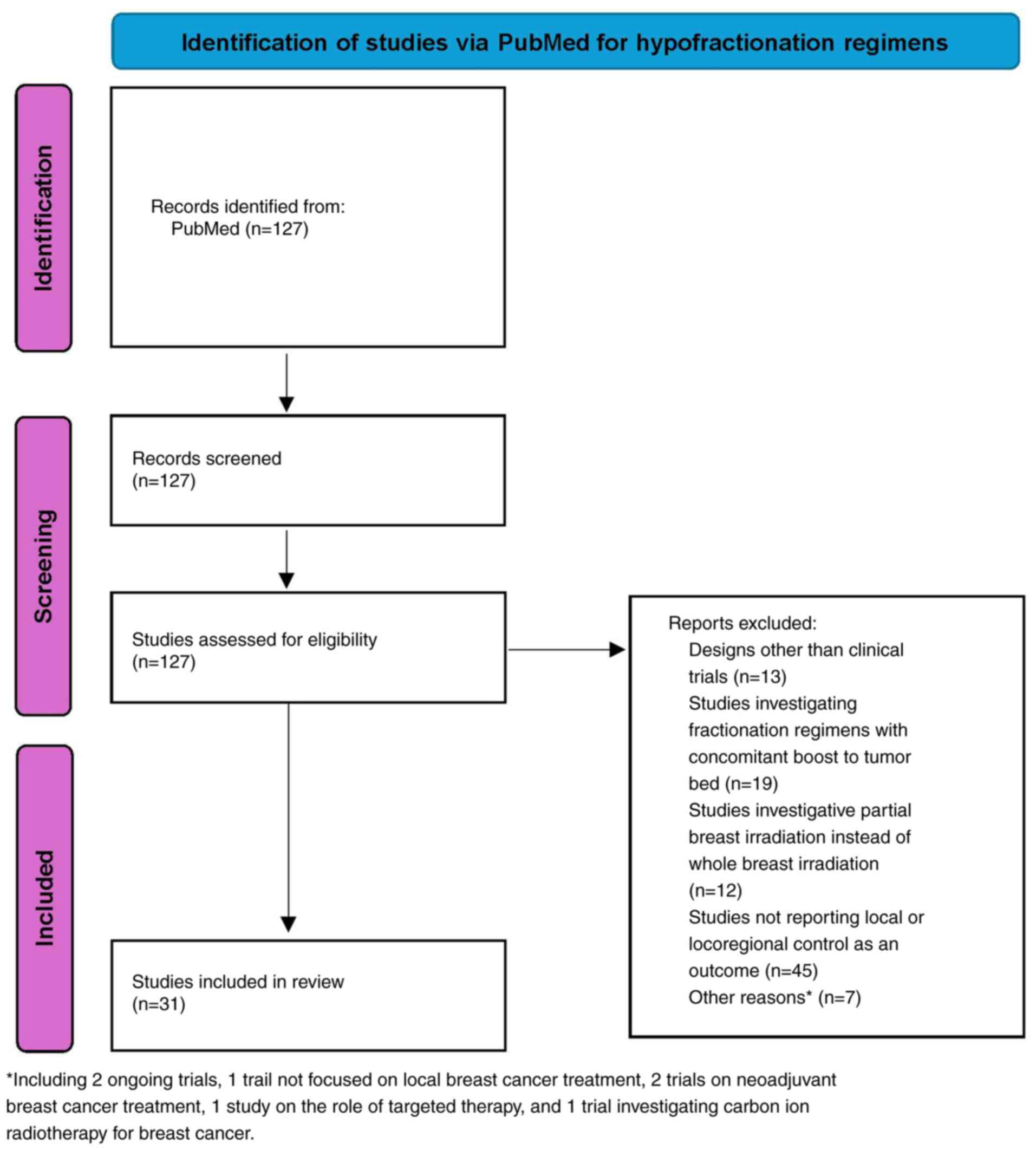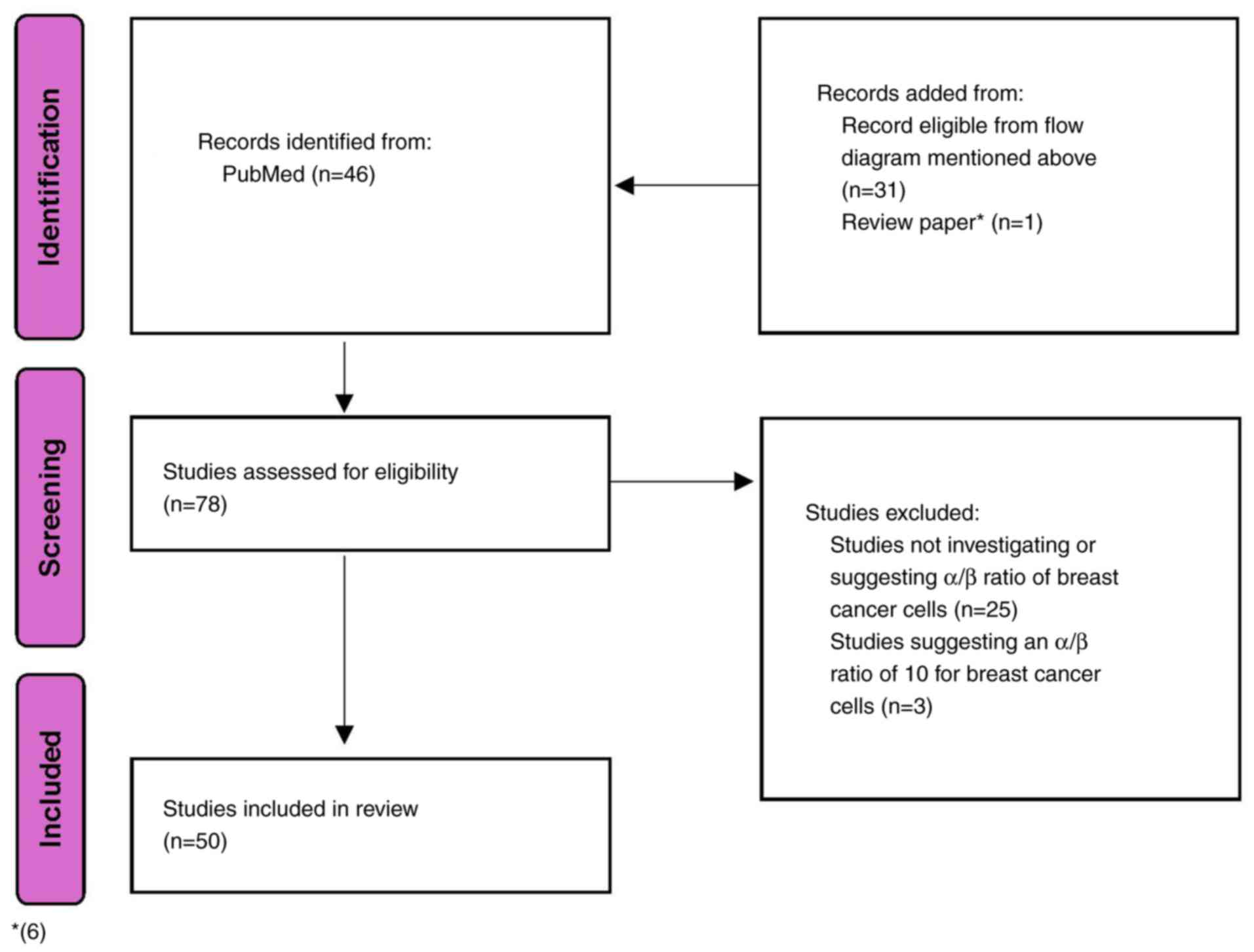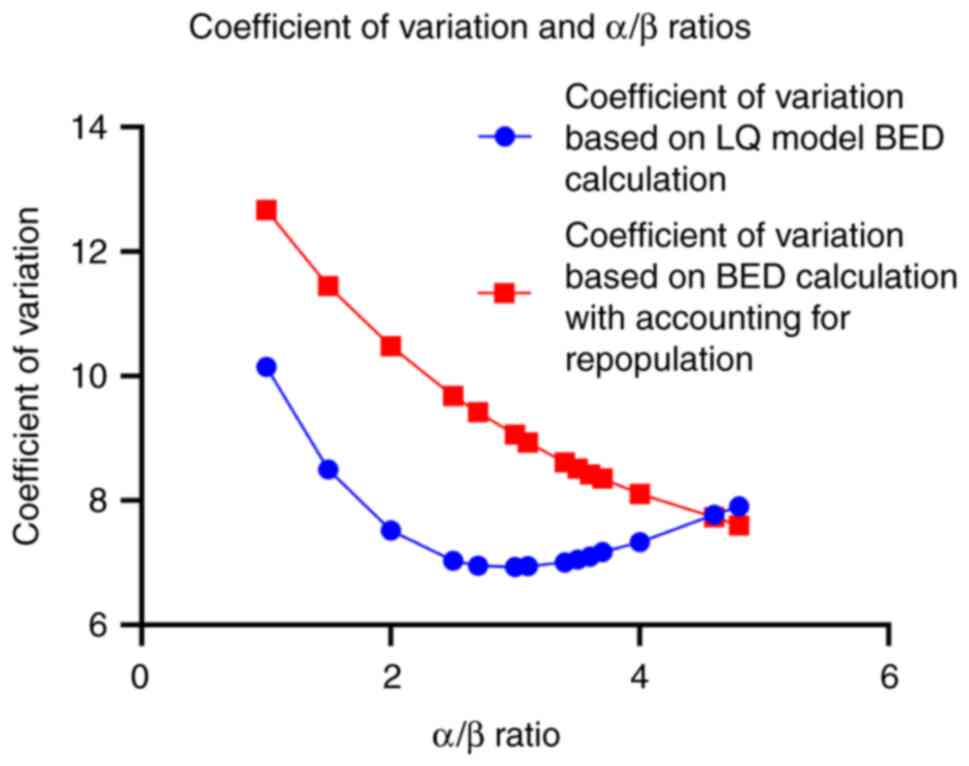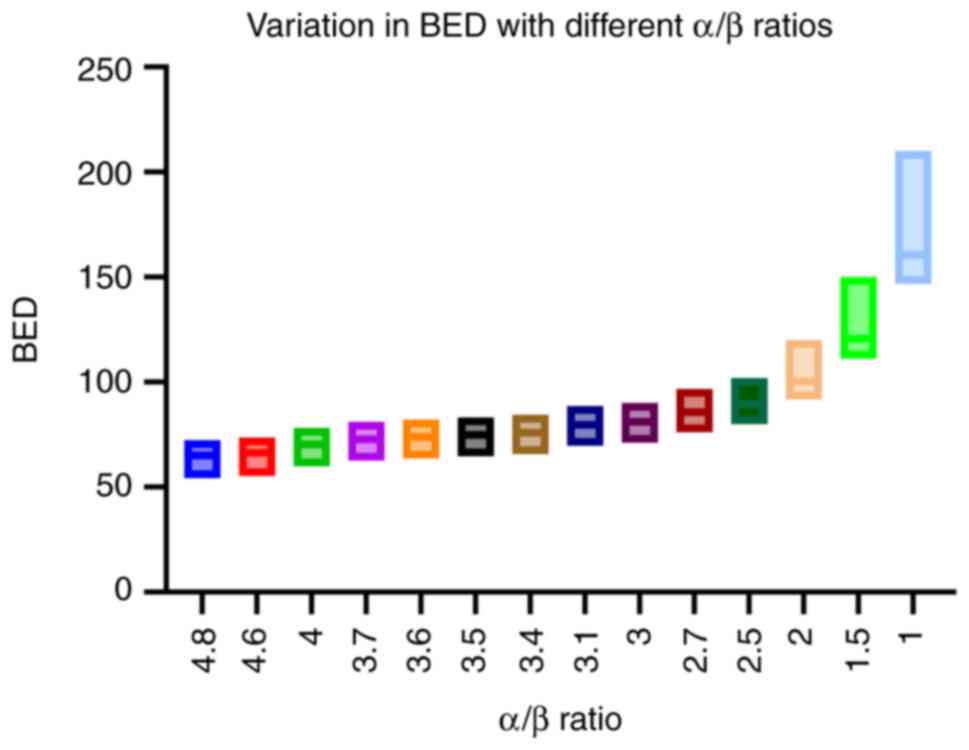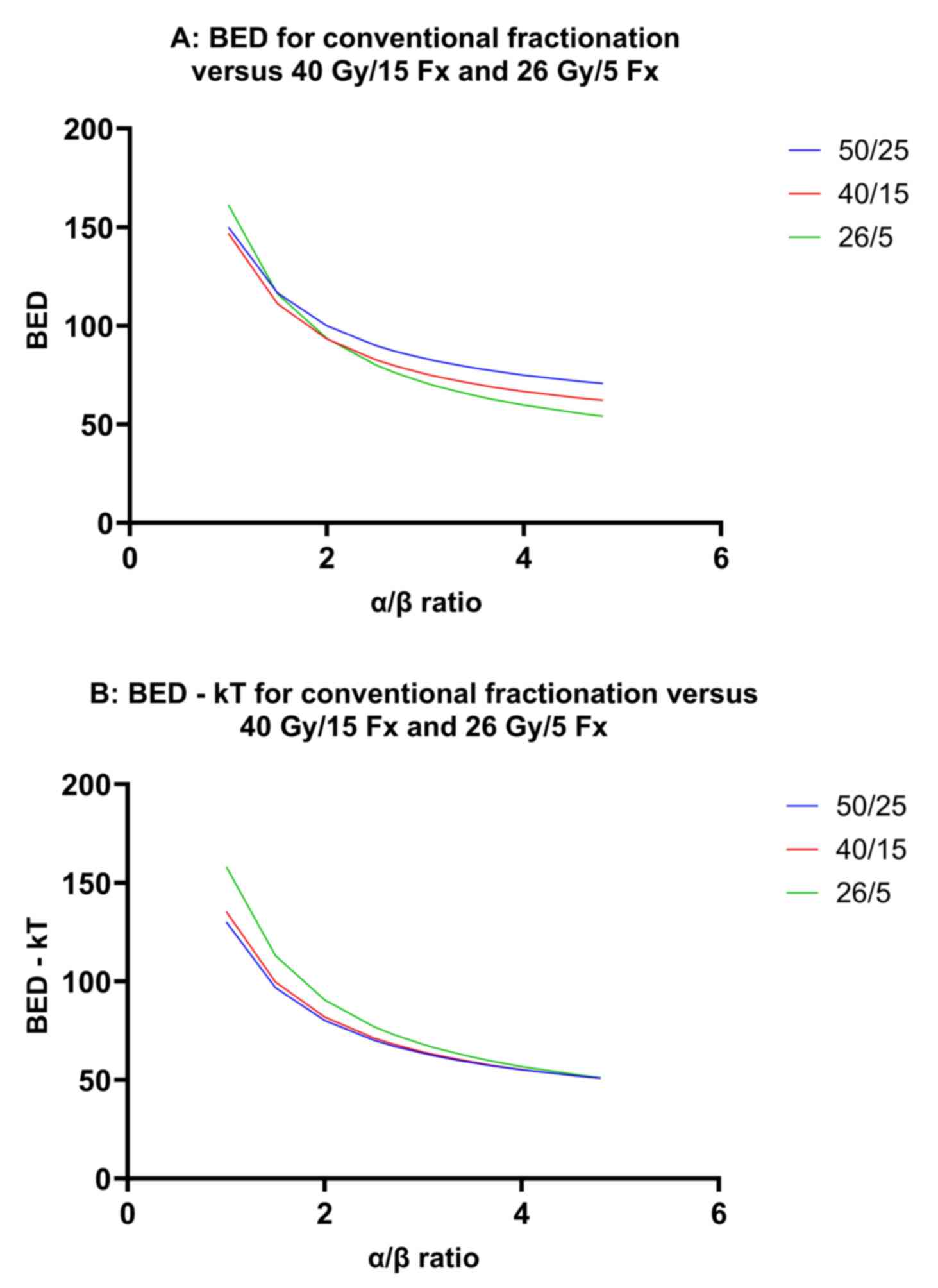|
1
|
Sung H, Ferlay J, Siegel RL, Laversanne M,
Soerjomataram I, Jemal A and Bray F: Global cancer statistics 2020:
GLOBOCAN estimates of incidence and mortality worldwide for 36
cancers in 185 countries. CA Cancer J Clin. 71:209–49.
2021.PubMed/NCBI View Article : Google Scholar
|
|
2
|
Fisher B, Anderson S, Bryant J, Margolese
RG, Deutsch M, Fisher ER, Jeong JH and Wolmark N: Twenty-year
follow-up of a randomized trial comparing total mastectomy,
lumpectomy, and lumpectomy plus irradiation for the treatment of
invasive breast cancer. N Engl J Med. 347:1233–1241.
2002.PubMed/NCBI View Article : Google Scholar
|
|
3
|
Darby S, McGale P, Correa C, Taylor C,
Arriagada R, Clarke M, Cutter D, Davies C, Ewertz M, Godwin J, et
al: Effect of radiotherapy after breast-conserving surgery on
10-year recurrence and 15-year breast cancer death: meta-analysis
of individual patient data for 10,801 women in 17 randomised
trials. Lancet. 378 (9804):1707:–1716. 2011.PubMed/NCBI View Article : Google Scholar : https://pubmed.ncbi.nlm.nih.gov/22019144/.
|
|
4
|
Tutt A and Yarnold J: Radiobiology of
breast cancer. Clin Oncol (R Coll Radiol). 18:166–178.
2006.PubMed/NCBI View Article : Google Scholar
|
|
5
|
Yarnold J, Ashton A, Bliss J, Homewood J,
Harper C, Hanson J, Haviland J, Bentzen S and Owen R: Fractionation
sensitivity and dose response of late adverse effects in the breast
after radiotherapy for early breast cancer: Long-term results of a
randomised trial. Radiother Oncol. 75:9–17. 2005.PubMed/NCBI View Article : Google Scholar
|
|
6
|
START Trialists' Group. Bentzen SM,
Agrawal RK, Aird EG, Barrett JM, Barrett-Lee PJ, Bliss JM, Brown J,
Dewar JA, Dobbs HJ, et al: The UK standardisation of breast
radiotherapy (START) trial A of radiotherapy hypofractionation for
treatment of early breast cancer: A randomised trial. Lancet Oncol.
9:331–341. 2008.PubMed/NCBI View Article : Google Scholar
|
|
7
|
Haviland JS, Owen JR, Dewar JA, Agrawal
RK, Barrett J, Barrett-Lee PJ, Dobbs HJ, Hopwood P, Lawton PA,
Magee BJ, et al: The UK Standardisation of breast radiotherapy
(START) trials of radiotherapy hypofractionation for treatment of
early breast cancer: 10-Year follow-up results of two randomised
controlled trials. Lancet Oncol. 14:1086–1094. 2013.PubMed/NCBI View Article : Google Scholar
|
|
8
|
Brunt AM, Haviland JS, Sydenham M, Agrawal
RK, Algurafi H, Alhasso A, Barrett-Lee P, Bliss P, Bloomfield D,
Bowen J, et al: Ten-year results of fast: A randomized controlled
trial of 5-fraction whole-breast radiotherapy for early breast
cancer. J Clin Oncol. 38:3261–3272. 2020.PubMed/NCBI View Article : Google Scholar
|
|
9
|
Murray Brunt A, Haviland JS, Wheatley DA,
Sydenham MA, Alhasso A, Bloomfield DJ, Chan C, Churn M, Cleator S,
Coles CE, et al: Hypofractionated breast radiotherapy for 1 week
versus 3 weeks (FAST-Forward): 5-year efficacy and late normal
tissue effects results from a multicentre, non-inferiority,
randomised, phase 3 trial. Lancet. 395:1613–1626. 2020.PubMed/NCBI View Article : Google Scholar
|
|
10
|
McMahon SJ: The linear quadratic model:
Usage, interpretation and challenges. Phys Med Biol.
64(01TR01)2018.PubMed/NCBI View Article : Google Scholar
|
|
11
|
Owen JR, Ashton A, Bliss JM, Homewood J,
Harper C, Hanson J, Haviland J, Bentzen SM and Yarnold JR: Effect
of radiotherapy fraction size on tumour control in patients with
early-stage breast cancer after local tumour excision: Long-term
results of a randomised trial. Lancet Oncol. 7:467–471.
2006.PubMed/NCBI View Article : Google Scholar
|
|
12
|
Brunt AM, Haviland JS, Kirby AM, Somaiah
N, Wheatley DA, Bliss JM and Yarnold JR: Five-fraction radiotherapy
for breast cancer: FAST-forward to implementation. Clin Oncol (R
Coll Radiol). 33:430–439. 2021.PubMed/NCBI View Article : Google Scholar
|
|
13
|
START Trialists' Group. Bentzen SM,
Agrawal RK, Aird EG, Barrett JM, Barrett-Lee PJ, Bentzen SM, Bliss
JM, Brown J, Dewar JA, et al: The UK standardisation of breast
radiotherapy (START) trial B of radiotherapy hypofractionation for
treatment of early breast cancer: A randomised trial. Lancet.
371:1098–1107. 2008.PubMed/NCBI View Article : Google Scholar
|
|
14
|
Smith BD, Bellon JR, Blitzblau R, Freedman
G, Haffty B, Hahn C, et al: Radiation therapy for the whole breast:
An American society for radiation oncology (ASTRO) evidence-based
guideline conflict of interest disclosure statement
acknowledgements for literature review and administrative support
and. Pract Radiat Oncol, 2018. https://pubmed.ncbi.nlm.nih.gov/29545124/.
|
|
15
|
Brand DH, Kirby AM, Yarnold JR and Somaiah
N: How low can you go? The radiobiology of hypofractionation. Clin
Oncol (R Coll Radiol). 34:280–287. 2022.PubMed/NCBI View Article : Google Scholar
|
|
16
|
Turesson I and Thames HD: Repair capacity
and kinetics of human skin during fractionated radiotherapy:
Erythema, desquamation, and telangiectasia after 3 and 5 year's
follow-up. Radiother Oncol. 15:169–188. 1989.PubMed/NCBI View Article : Google Scholar
|
|
17
|
Meattini I, Becherini C, Boersma L,
Kaidar-Person O, Marta GN, Montero A, Offersen BV, Aznar MC, Belka
C, Brunt AM, et al: European society for radiotherapy and oncology
advisory committee in radiation oncology practice consensus
recommendations on patient selection and dose and fractionation for
external beam radiotherapy in early breast cancer. Lancet Oncol.
23:e21–e31. 2022.PubMed/NCBI View Article : Google Scholar
|
|
18
|
Evidence review for the effectiveness of
different external beam hypofractionation radiotherapy regimens in
people with early-stage or locally advanced invasive breast cancer:
Early and locally advanced breast cancer: Diagnosis and management.
NICE Evidence Reviews Collection, 2023.
|
|
19
|
Monten C and Lievens Y: Adjuvant breast
radiotherapy: How to trade-off cost and effectiveness? Radiother
Oncol. 126:132–138. 2018.PubMed/NCBI View Article : Google Scholar
|
|
20
|
Yaremko HL, Locke GE, Chow R, Lock M,
Dinniwell R and Yaremko BP: Cost minimization analysis of
hypofractionated radiotherapy. Curr Oncol. 28:716–725.
2021.PubMed/NCBI View Article : Google Scholar
|
|
21
|
Glynn D, Bliss J, Brunt AM, Coles CE,
Wheatley D, Haviland JS, Kirby AM, Longo F, Faria R, Yarnold JR and
Griffin S: Cost-effectiveness of 5 fraction and partial breast
radiotherapy for early breast cancer in the UK: Model-based
multi-trial analysis. Breast Cancer Res Treat. 197:405–416.
2023.PubMed/NCBI View Article : Google Scholar
|
|
22
|
Batumalai V, Delaney GP, Descallar J,
Gabriel G, Wong K, Shafiq J and Barton M: Variation in the use of
radiotherapy fractionation for breast cancer: Survival outcome and
cost implications. Radiother Oncol. 152:70–77. 2020.PubMed/NCBI View Article : Google Scholar
|
|
23
|
Ali AA, Tawk R, Xiao H, Semykina A,
Montero AJ, Moussa RK, Popoola O and Diaby V: Comparative
cost-effectiveness of radiotherapy among older women with hormone
receptor positive early-stage breast cancer. Expert Rev
Pharmacoecon Outcomes Res. 22:735–741. 2022.PubMed/NCBI View Article : Google Scholar
|
|
24
|
Ward MC, Recht A, Vicini F, Al-Hilli Z,
Asha W, Chadha M, Abraham A, Thaker N, Khan AJ, Keisch M and Shah
C: Cost-effectiveness analysis of ultra-hypofractionated whole
breast radiation therapy alone versus hormone therapy alone or
combined treatment for low-risk ER-positive early stage breast
cancer in women aged 65 years and older. Int J Radiat Oncol Biol
Phys. 116:617–626. 2023.PubMed/NCBI View Article : Google Scholar
|
|
25
|
Guerrero M and Li XA: Analysis of a large
number of clinical studies for breast cancer radiotherapy:
Estimation of radiobiological parameters for treatment planning.
Phys Med Biol. 48:3307–3326. 2003.PubMed/NCBI View Article : Google Scholar
|
|
26
|
Niemierko A: Reporting and analyzing dose
distributions: A concept of equivalent uniform dose. Med Phys.
24:103–110. 1997.PubMed/NCBI View
Article : Google Scholar
|
|
27
|
Wang JZ and Li XA: Evaluation of external
beam radiotherapy and brachytherapy for localized prostate cancer
using equivalent uniform dose. Med Phys. 30:34–40. 2003.PubMed/NCBI View Article : Google Scholar
|
|
28
|
Smith W, Menon G, Wolfe N, Ploquin N,
Trotter T and Pudney D: IMRT for the breast: A comparison of
tangential planning techniques. Phys Med Biol. 55:1231–1241.
2010.PubMed/NCBI View Article : Google Scholar
|
|
29
|
Isaksson LJ, Pepa M, Zaffaroni M, Marvaso
G, Alterio D, Volpe S, Corrao G, Augugliaro M, Starzyńska A,
Leonardi MC, et al: Machine learning-based models for prediction of
toxicity outcomes in radiotherapy. Front Oncol.
10(790)2020.PubMed/NCBI View Article : Google Scholar
|
|
30
|
Desideri I, Loi M, Francolini G, Becherini
C, Livi L and Bonomo P: Application of radiomics for the prediction
of radiation-induced toxicity in the IMRT era: Current
state-of-the-art. Front Oncol. 10(1708)2020.PubMed/NCBI View Article : Google Scholar
|
|
31
|
Feng H, Wang H, Xu L, Ren Y, Ni Q, Yang Z,
Ma S, Deng Q, Chen X, Xia B, et al: Prediction of radiation-induced
acute skin toxicity in breast cancer patients using data
encapsulation screening and dose-gradient-based multi-region
radiomics technique: A multicenter study. Front Oncol.
12(1017435)2022.PubMed/NCBI View Article : Google Scholar
|
|
32
|
Choi BS, Yoo SK, Moon J, Chung SY, Oh J,
Baek S, Kim Y, Chang JS, Kim H and Kim JS: Acute coronary event
(ACE) prediction following breast radiotherapy by features
extracted from 3D CT, dose, and cardiac structures. Med Phys.
50:6409–6420. 2023.PubMed/NCBI View
Article : Google Scholar
|
|
33
|
Avanzo M, Pirrone G, Vinante L, Caroli A,
Stancanello J, Drigo A, Massarut S, Mileto M, Urbani M, Trovo M, et
al: Electron density and biologically effective dose (BED)
radiomics-based machine learning models to predict late
radiation-induced subcutaneous fibrosis. Front Oncol.
10(490)2020.PubMed/NCBI View Article : Google Scholar
|
|
34
|
Durdik M, Markova E, Kosik P, Vigasova K,
Gulati S, Jakl L, Vrobelova K, Fekete M, Zavacka I, Pobijakova M,
et al: Assessment of individual radiosensitivity in breast cancer
patients using a combination of biomolecular markers. Biomedicines.
11(1122)2023.PubMed/NCBI View Article : Google Scholar
|
|
35
|
Somaiah N, Rothkamm K and Yarnold J: Where
do we look for markers of radiotherapy fraction size sensitivity?
Clin Oncol (R Coll Radiol). 27:570–578. 2015.PubMed/NCBI View Article : Google Scholar
|
|
36
|
Ahmed KA, Liveringhouse CL, Mills MN,
Figura NB, Grass GD, Washington IR, Harris EE, Czerniecki BJ,
Blumencranz PW, Eschrich SA, et al: Utilizing the genomically
adjusted radiation dose (GARD) to personalize adjuvant radiotherapy
in triple negative breast cancer management. EBioMedicine.
47:163–169. 2019.PubMed/NCBI View Article : Google Scholar
|
|
37
|
Anbalagan S, Ström C, Downs JA, Jeggo PA,
McBay D, Wilkins A, Rothkamm K, Harrington KJ, Yarnold JR and
Somaiah N: TP53 modulates radiotherapy fraction size sensitivity in
normal and malignant cells. Sci Rep. 11(7119)2021.PubMed/NCBI View Article : Google Scholar
|
|
38
|
Seibold P, Webb A, Aguado-Barrera ME,
Azria D, Bourgier C, Brengues M, Briers E, Bultijnck R,
Calvo-Crespo P, Carballo A, et al: REQUITE: A prospective
multicentre cohort study of patients undergoing radiotherapy for
breast, lung or prostate cancer. Radiother Oncol. 138:59–67.
2019.PubMed/NCBI View Article : Google Scholar
|
|
39
|
Page MJ, McKenzie JE, Bossuyt PM, Boutron
I, Hoffmann TC, Mulrow CD, Shamseer L, Tetzlaff JM, Akl EA, Brennan
SE, et al: The PRISMA 2020 statement: An updated guideline for
reporting systematic reviews. PLOS Med. 18(e1003583)2021.PubMed/NCBI View Article : Google Scholar
|



